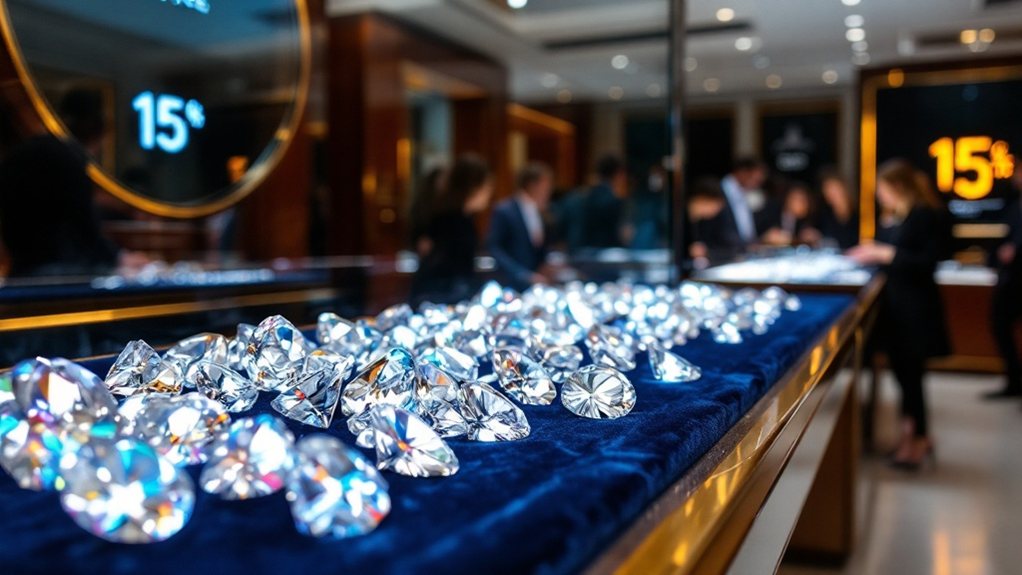Article Contents
- 1 Market Challenges and Context
- 2 Details of the Price Reduction
- 3 Shifting Consumer Preferences
- 4 Industry Reactions and Strategies
- 5 Future Market Outlook
- 6 Frequently Asked Questions
- 6.1 How Will the Price Cut Affect De Beers’ Financial Performance?
- 6.2 What Is De Beers’ Market Share Compared to Competitors?
- 6.3 How Do Lab-Grown Diamonds Impact De Beers’ Brand Image?
- 6.4 Are There Any Legal Challenges De Beers Faces Due to Price Cuts?
- 6.5 What Are the Implications for De Beers’ Partnerships With Jewelry Retailers?
- 7 Conclusion
De Beers has announced a 15% reduction in diamond prices amid significant market challenges, including decreased natural diamond production and a slump in luxury spending due to economic instability. Factors such as inflation, a weakened Chinese market, and supply chain disruptions have compounded these issues. Furthermore, the growing popularity of lab-grown diamonds, now comprising 20% of global sales, pressures natural diamond prices even further. Despite the price cuts, manufacturers express concerns over profitability, indicating possible further adjustments. This strategic move by De Beers highlights the shifting landscape of the diamond industry, with implications for market recovery and consumer trends unfolding.
Market Challenges and Context
Amidst a backdrop of fluctuating global market conditions, De Beers has been compelled to adjust its diamond pricing strategy in response to several persistent challenges.
The world has witnessed natural diamond production plummet to 111.5 million carats in 2023, the lowest in two decades. This decline is compounded by inflationary pressures that have curbed luxury spending, alongside a weakened Chinese market, which has historically been a significant driver of demand. Furthermore, the industry is grappling with the rise of synthetic competition, where lab-grown diamonds have dramatically altered market dynamics. With their production costs dropping from $4,000 to $400 per stone since 2008, synthetic diamonds now account for 20% of global diamond jewelry sales. The anticipated growth of synthetic diamond production, projected to double to 19 million carats by 2030, underscores the pressing need for traditional diamond sectors to adapt. In light of these developments, De Beers’ CEO Al Cook forecasts a gradual recovery of the natural diamond market in 2024, highlighting the importance of strategic adaptation.
Supply chain disruptions further exacerbate these challenges, as major diamond mines approach depletion. Sanctions on Russian diamonds, slated to intensify by 2025, also threaten to constrict supply channels. Geopolitical tensions and financing shifts pose additional challenges for the industry, further complicating the market landscape.
In response, De Beers has invested heavily in extending mine lifetimes, such as the significant financial outlays on the Jwaneng and Venetia mines.
As the industry navigates these turbulent waters, the need for strategic adaptation and innovation becomes imperative, particularly in differentiating natural diamonds from their synthetic counterparts.
Details of the Price Reduction

De Beers’ decision to reduce diamond prices stems directly from the market challenges previously outlined. The company has instituted a 10% to 15% price cut across most diamond categories, particularly focusing on those with the weakest demand trends. This strategic move represents the most significant adjustment in years, yet prices still hover above secondary market levels, presenting a complex scenario for manufacturers who continue to grapple with profitability issues. Recently, industry discussions have emphasized the importance of establishing verification nodes in Angola to ensure market stability and transparency. The price adjustment strategy involves significant changes, including the removal of extra supply flexibility introduced during the recent downturn. De Beers has reverted to standard buybacks for smaller sizes, allowing up to 10% of goods to be returned. The emergence of lab-grown diamonds as a popular and cost-effective alternative has put additional pressure on De Beers to adapt its pricing strategy. The company is also navigating the potential spin-off or sale by Anglo American Plc, which could reshape its future operations.
Significantly, for 4-grainers (1 carat) and larger diamonds, buybacks have increased to 20% from the previous 10%. This approach aims to minimize negative sentiment by distributing reductions more evenly, though uncertainty lingers about potential further decreases in January.
Reactions from sightholders and industry executives have been mixed, with some leaving substantial goods on the table due to weak polished sales. Executives have expressed disappointment, indicating that deeper cuts might be necessary to align prices with current market valuations.
Shifting Consumer Preferences
The evolving landscape of consumer preferences is increasingly impacting the natural diamond market, as a considerable number of buyers shift towards lab-grown diamonds. This shift is particularly evident in the United States, where one-third of couples opted for lab-grown engagement rings in 2022, a trend anticipated to grow. The lab-grown diamond market is attractive to price-conscious buyers due to its affordability and near-identical crystal structure and composition to natural diamonds. Younger generations, prioritizing environmental consciousness, find lab-grown diamonds a sustainable alternative, further reducing demand for natural diamonds.
The 6% decline in natural diamond prices in 2024 underscores the growing challenges faced by the traditional diamond industry as it contends with shifting consumer preferences. Round diamonds dominate the market with 82.97% popularity, highlighting that traditional shapes still hold a significant place despite the rise of lab-grown diamonds. Consumer education plays a pivotal role in this change.
As consumers become more informed, they are better equipped to discern the lab-grown advantages, such as cost-effectiveness and ethical production. This heightened awareness encourages individuals to evaluate their purchasing decisions critically, often favoring lab-grown options. Furthermore, the economic uncertainty in major markets like the US and China exacerbates this shift.
With reduced consumer confidence and spending power, buyers increasingly seek value in their luxury purchases, turning to more affordable alternatives like lab-grown diamonds. The stabilization of diamond prices in the latter half of the year suggests cautious optimism among industry stakeholders trying to navigate these challenges. As a result, the natural diamond market continues to face challenges in maintaining its traditional consumer base.
Industry Reactions and Strategies

While facing the dynamic challenges of the modern diamond market, De Beers has adopted a strategic approach to address declining demand and profitability pressures by reducing rough diamond prices by 10% to 15%. This pricing strategy tries to close the gap between what De Beers is selling and what the open market valuations. The goal is to keep the market stable when demand is low, especially in categories that aren’t doing well.
Industry experts note that this price reduction is a pivotal moment for De Beers, signaling challenges in the diamond market. However, sightholder feedback indicates that even with these adjustments, De Beers’ rough diamonds remain 5% to 10% more costly than those available at tenders and auctions. The industry reactions are mixed, with many manufacturers expressing concerns that the price cuts are insufficient to guarantee profitability, especially as they navigate the complexities of the polished diamond market. Despite some stabilization in polished prices, the thin margins persist, prompting calls for more significant reductions. This sentiment underscores the growing pressure on De Beers to reassess its pricing strategy more aggressively to align with current market realities. Many stakeholders argue that without further de Beers diamond price cuts, manufacturers may struggle to sustain operations amid tightening margins and subdued consumer demand. The broader industry anticipates that any additional adjustments could not only bolster confidence among sightholders but also help De Beers regain its competitive edge in an increasingly challenging landscape. In response to these challenges, De Beers has announced that it will implement further de Beers diamond price cuts in the coming months. The company recognizes the need to address the concerns of sightholders and maintain a competitive position in the market. By taking this proactive approach, De Beers aims to provide some relief to manufacturers and stimulate renewed interest in diamond trading. However, the effectiveness of these price cuts will hinge on how they are received by the industry and whether they are substantial enough to offset the ongoing pressures on profitability. Industry analysts are closely monitoring the impact of these upcoming de Beers diamond price cuts on the market. There is cautious optimism that the reductions will help alleviate some of the financial strain on manufacturers, but concerns remain about the long-term sustainability of the diamond industry. With consumer demand still subdued and polished diamond prices fluctuating, the effectiveness of these price cuts in stabilizing the market remains uncertain. The industry eagerly awaits the implementation of these adjustments and hopes they will provide the necessary support for businesses operating within the diamond supply chain.
De Beers, which conducts 10 sales annually and sets fixed pricing for sightholders, views the strategic shift from maintaining high prices to aligning with market realities as a necessary measure to prevent further destabilization, particularly as polishing operations resume after the Diwali break.
Future Market Outlook
The diamond industry is in a rapidly evolving marketplace where shifting consumer preferences and economic constraints challenge traditional norms. The ongoing turbulence necessitates a strategic reassessment of investment potential and market recovery pathways. De Beers’ decision to slash diamond prices by 15% underscores the urgency of aligning with current market realities. However, whether this move suffices to stimulate demand remains uncertain, particularly amid weak demand in China’s luxury sector and inflationary pressures.
| Market Challenges | Consumer Trends |
|---|---|
| Weak demand in luxury market | Preference for lab-grown diamonds |
| Lab-grown diamond competition | Affordability and sustainability |
| Economic slowdown | Shift from traditional symbols |
| Inflation pressures | Social and environmental concerns |
| Sanction-induced disruptions | Lower costs of lab-grown options |
The market recovery hinges on embracing lab-grown diamonds’ acceptance as a viable luxury option, potentially revealing new avenues for growth. The stabilization of polished diamond prices, coupled with the reopening of polishing operations, hints at a more balanced market outlook. Producers must remain agile, adapting to consumer demands and economic shifts. Through creative strategies and competitive pricing, the industry can navigate these challenges, positioning itself for sustained recovery and long-term investment potential.
Frequently Asked Questions
How Will the Price Cut Affect De Beers’ Financial Performance?
The price reduction may initially challenge De Beers’ financial stability, potentially affecting investor confidence. However, aligning prices with market demands might improve competitiveness and market share, ultimately supporting long-term financial performance and investor trust if executed effectively.
De Beers holds a 29% market share, slightly behind Alrosa’s 31%, reflecting evolving market dynamics. Competitor analysis indicates De Beers’ historical dominance faces challenges from shifting consumer preferences and technological advancements, particularly the rise of lab-grown diamonds.
How Do Lab-Grown Diamonds Impact De Beers’ Brand Image?
Like a diamond in the rough, lab-grown diamonds challenge De Beers’ brand perception by reshaping consumer preferences. As ethical consumption gains traction, De Beers must adapt to preserve its image amidst shifting luxury paradigms and market dynamics.
Are There Any Legal Challenges De Beers Faces Due to Price Cuts?
The current question examines potential legal challenges De Beers may face concerning price cuts, specifically antitrust concerns and regulatory scrutiny. Presently, no direct legal challenges are reported, suggesting compliance with industry standards and market regulations.
What Are the Implications for De Beers’ Partnerships With Jewelry Retailers?
The implications for De Beers’ partnerships with jewelry retailers involve reassessing retailer relationships and pricing strategies. Retailers demand sustainable profitability, necessitating De Beers to align pricing strategies with market realities, ensuring partnership sustainability amidst evolving consumer preferences and economic conditions.
Conclusion
In a twist of irony, the esteemed De Beers, synonymous with diamond opulence, now navigates turbulent waters, reducing prices by a remarkable 15%. This strategic move, driven by shifting consumer preferences and a volatile market, prompts varied reactions within the industry. While some stakeholders hasten to adapt, others ponder the long-term implications of such a significant price adjustment. The future of the diamond market remains uncertain, compelling industry players to reevaluate strategies amidst evolving consumer demands.

